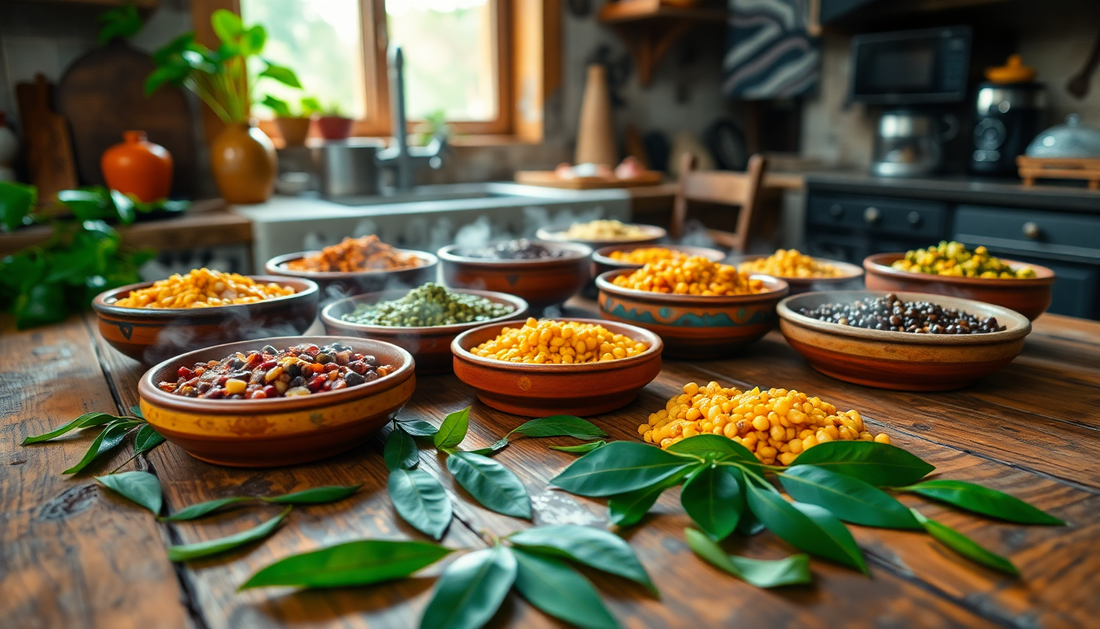
Unlock the Flavor Secrets of Lentil Dishes with Curry Leaves
Share
Curry leaves are a staple ingredient in many Indian households, adding a unique and aromatic flavor to a variety of dishes. While they are commonly used in curries, these versatile leaves can also elevate the taste of lentil-based dishes, transforming them into flavorful and comforting meals. In this comprehensive guide, we'll explore the art of incorporating curry leaves into your lentil recipes, unlocking the secrets to creating truly delectable and authentic Indian-inspired dishes.
The Essence of Curry Leaves
Curry leaves, botanically known as Murraya koenigii, are the fragrant leaves of a tropical evergreen tree native to India. These small, oblong-shaped leaves are packed with a distinct aroma and flavor that is often described as a combination of citrus, pine, and a subtle bitterness. They are an integral part of many South Indian and Sri Lankan cuisines, where they are used to add depth and complexity to a wide range of dishes.
Beyond their culinary applications, curry leaves are also revered for their potential health benefits. They are believed to be rich in antioxidants, vitamins, and minerals, making them a valuable addition to a balanced diet. From aiding in digestion to potentially supporting cardiovascular health, the versatility of curry leaves extends far beyond their role as a flavorful ingredient.
Incorporating Curry Leaves into Lentil Dishes
Lentils, or "dal" as they are commonly known in Indian cuisine, are a staple protein-rich food that can be prepared in countless ways. When combined with the aromatic essence of curry leaves, lentil dishes take on a whole new level of flavor and complexity. Here are some tips for incorporating curry leaves into your lentil recipes:
Tempering Lentils with Curry Leaves
One of the most common ways to use curry leaves in lentil dishes is through the process of tempering, also known as "tadka" or "chaunk." This technique involves briefly frying the curry leaves in hot oil or ghee, releasing their essential oils and infusing the oil with their unique aroma. The fragrant oil is then poured over the cooked lentils, instantly elevating the dish with a burst of flavor.
Simmering Lentils with Curry Leaves
For a more subtle and integrated flavor, you can add whole or chopped curry leaves directly to the lentil cooking liquid. As the lentils simmer, the leaves will release their essence, infusing the entire dish with their distinctive taste. This method works particularly well for dals and lentil-based stews, where the curry leaves can mingle with the other spices and aromatics.
Garnishing with Fresh Curry Leaves
If you want to showcase the vibrant green color and fresh aroma of curry leaves, consider using them as a garnish for your lentil dishes. Simply tear or chop the leaves and sprinkle them over the cooked lentils just before serving. This not only adds a visually appealing touch but also provides a refreshing burst of flavor with each bite.
Lentil Recipes Featuring Curry Leaves
Now that you understand the role of curry leaves in lentil dishes, let's explore some delicious recipes that showcase their flavor-enhancing abilities:
Masoor Dal with Curry Leaves
This classic red lentil dal is a comforting and nourishing dish that is elevated by the addition of curry leaves. The tempering process, where the leaves are fried in oil or ghee, infuses the dal with a fragrant and slightly bitter note that perfectly complements the earthy lentils.
Moong Dal with Curry Leaves
Yellow moong dal is a versatile lentil that pairs beautifully with the bright and citrusy notes of curry leaves. Simmering the lentils with whole curry leaves and other spices creates a harmonious blend of flavors, resulting in a dish that is both satisfying and aromatic.
Chana Dal with Curry Leaves
Chana dal, made from split and hulled chickpeas, is a heartier lentil that benefits from the complexity that curry leaves bring. The combination of the nutty chana dal and the fragrant curry leaves results in a dish that is both comforting and deeply flavorful.
Lentil and Vegetable Stew with Curry Leaves
For a more substantial lentil-based meal, consider a stew that incorporates a variety of vegetables and is seasoned with curry leaves. The leaves infuse the entire dish with their distinctive aroma, creating a harmonious blend of textures and flavors in every spoonful.
Maximizing the Flavor of Curry Leaves
To ensure you get the most out of your curry leaves, it's important to handle and store them properly. Here are some tips:
- Source fresh, vibrant leaves: Look for curry leaves that are deep green in color and free from blemishes or wilting.
- Store them properly: Wrap the leaves in a damp paper towel and place them in an airtight container in the refrigerator. This will help preserve their freshness and aroma.
- Use them at the right time: For maximum flavor, add curry leaves towards the end of the cooking process or use them as a garnish. Prolonged cooking can cause the leaves to lose their delicate flavor.
- Experiment with different forms: In addition to using whole leaves, try chopping or tearing them to release more of their essential oils and enhance the overall flavor profile.
By following these tips and incorporating curry leaves into your lentil dishes, you'll unlock a world of aromatic and flavorful possibilities. From comforting dals to hearty stews, the addition of these fragrant leaves can transform your lentil-based meals into truly exceptional culinary experiences.
So, the next time you're planning a lentil-centric dish, don't forget the power of curry leaves. Embrace their unique flavor profile and let it elevate your lentil recipes to new heights of deliciousness.

